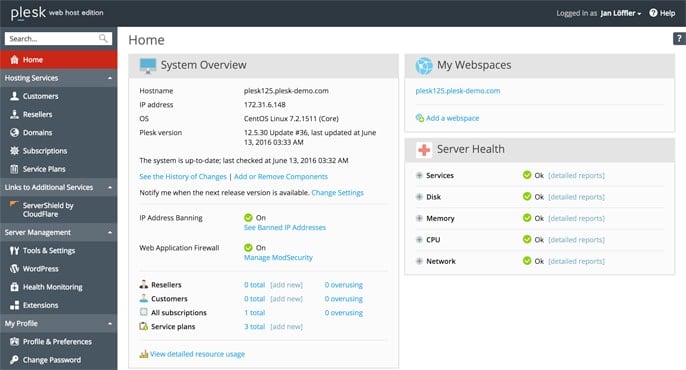
If you’re a Reseller and this happens, you can simply use the built-in DirectAdmin ticket system to message your customers that a crash took place. Here, any faulty service gets restarted and if that still doesn’t help, the Admin is notified.

To keep things safe and sound, ClamAV and ModSecurity are supported by default with DirectAdmin.Īnd, in case of a computer crash, its automatic recovery feature means avoiding unnecessary downtime. Hate spam? DirectAdmin supports spam-filtering programs such as SpamAssassin (also used by cPanel). In addition to DNS management, IP configurations, account management, and more, DirectAdmin offers you a helpful overview of all the server resources that are currently in use.Īs for web servers, it supports Apache, Nginx, Litespeed, and Open Litespeed. With its efficient user interface, customization is made easy by simply changing the visible number of menus for the end-user and/or importing new interface designs. DirectAdminĬreated by JBMC Software, DirectAdmin is a standalone control panel that supports Linux and is one of the most affordable alternatives to cPanel.ĭirectAdmin offers three access types (Admins, Resellers, Users), each limiting the control options depending on the user role. The bottom line? If you’re using a non-Linux hosting environment or you prefer a control panel that’s super simple to use, you can’t go wrong with Plesk. The price? Plesk comes with three plans to choose from: WebAdmin, WebPro, and Webhost, with the WebAdmin plan starting at just $10/month. Already have a control panel? Plesk features a plugin that allows for easy migration. If you use Plesk, you can also easily integrate external resources, such as Git, Docker containers, and Dropbox to upload, download, and restore backups. This ranges from custom plugins and themes to performing post and installation cloning, staging, and migrating - in just one click. Looking to set up a WordPress website? Plesk comes with the automatic WordPress toolkit, which lets you manage all your WordPress applications from one location. Considered a “WebOps” server control panel, Plesk ranks high on security, offering integrated safety measures like Fail2Ban and Plesk Firewall. Plesk also allows for CLI management and supports DNS management, FTP accounts as well as MySQL databases.

cPanel offers separate panels to access WHM subscriptions and user management whereas with Plesk, you can input the Admin or other User credentials from one single login interface. Plesk, Plesk features a centralized control panel.

(Some would even argue that Plesk is friendlier than cPanel, but it’s a matter of opinion.) When comparing cPanel vs. Similar to cPanel, Plesk features an aesthetically-pleasing and user-friendly interface. So if you use Windows, Plesk is a sure bet.
#CPANEL VS WEBMIN WINDOWS#
Whereas cPanel runs on the Linux Operating System (OS), Plesk is supported on both Linux and Windows servers. PleskĪlso from the folks behind cPanel, Plesk is arguably the second most popular control panel on the market.

So without further ado, let’s take a closer look at the alternatives to cPanel and what they offer.
#CPANEL VS WEBMIN SOFTWARE#
The biggest distinction between cPanel and control panel alternatives boils down to their compatibility with certain software and their level of support provided.įor instance, while “open-source” control panels allow users to create feature requests and leave any feedback, this often means there isn’t a dedicated support team on hand to help tackle any roadblocks or issues. Most of these alternatives are “open-source” software, which means they are created and supported by a community of like-minded individuals.
#CPANEL VS WEBMIN LICENSE#
Given that cPanel announced last year an unexpected price change in their license billing system and their approach to license options, many hosting providers and customers started looking for alternatives. (For more background basics on cPanel, check out my previous article.) cPanel is a website hosting dashboard that runs on the Linux Operating System (OS) and helps simplify the management of your website with its graphic interface. So, what’s the most popular website hosting control panel on the market these days? cPanel, which was first introduced back in 1996. While some web hosting providers include a control panel with their plans, others offer a control panel to be purchased additionally. This inevitably means opting for a control panel, which lessens your technical load. As a first-time hosting customer, you’re more than likely going to need (and want!) something that helps manage your website’s server.


 0 kommentar(er)
0 kommentar(er)
